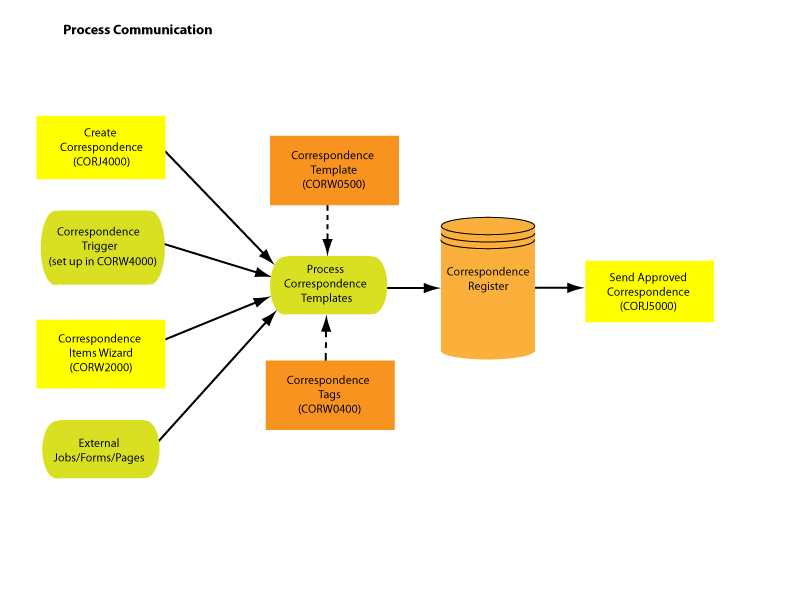
| Top of COR | Index | Table of Contents | Feedback |  |
Understanding Communication
Callista caters for four primary forms of communication with students:
Delivery and Content Types
Prior to sending a correspondence item to a recipient it is first necessary to configure the system and set up a template that will be merged with data from the database to form a communication item.
Delivery types (Letters, Email, etc.) are defined in CORF2600.
Content types (PDF, XML, Text, etc.) are defined in CORF2610.
Combinations of these are defined in CORF2630.

Templates
Correspondence templates are defined using the Correspondence Template Wizard - see CORW0500.
Here the user determines the delivery and content type of the communication, as well as all other information (e.g. for an email a user would also specify the subject, cc, bcc, etc.) and whether the items needs to be approved before being sent.
To allow data from the Callista database to be drawn into communication items, substitution tags must also be defined. These take the form of database SQL queries which return data from the database. Substitution tags are defined in CORW0400 (accessed via CORW0500). Images to be included in communication items are also defined by substitution tags - also defined in CORW0400 (accessed via CORW0500). These SQL and image tags are inserted into the template as part of the content.
Communication Templates and Substitution tags can also be catalogued by placing them in defined Communication categories. e.g. templates and tags used in Enrolment can be grouped into an Enrolment category. This makes them more readily accessed during Communication processing. This is done in CORW0600 (accessed via CORW0500).
Correspondence Type Groups, defined in CORW2690 (accessed via CORW0500), allow a user to set up a group of similar email templates to be sent as a single email, with the body of each message concatenated together into a single item.
Processing
An autonomous process is responsible for the processing (combining template with data) of communication types (templates) to generate communication items. Each item represents a piece of correspondence with a single recipient.
The Processing of Correspondence Templates involves the execution of SQL queries behind substitution variables, the parsing of the template, the insertion of data into the template and the sending of the final communication.
CORJ4000 creates communication items according to the parameters set.
CORJ5000 sends those communication items that are awaiting sending in the correspondence register. Such items are yet to be sent and either do not require approval, or do require approval and have already been approved.
Correspondence types can be defined such that items can be generated when certain events occur. Correspondence triggers are events (on an insert/update/delete event in the database) that can generate communication items.
A number of callista tables have System Correspondence Triggers associated with them, for which conditions can be defined which will trigger the generation of correspondence.
See Correspondence Trigger Registry for a list of these tables and their system triggers.
Multiple communication types can be recorded against the same system trigger to allow for catered communication to be sent out on specific events (i.e. a student is enrolled into a course – new record is inserted into STUDENT_COURSE_ATTEMPT with a status of enrolled).
The correspondence register is a table in the database that holds a record of all communication items that have been sent through this system. This includes all items that were created, but were rejected on review by an authorized user. Users access this register via the Correspondence Items Wizard - CORW2000. The wizard allows users to view past correspondence and re-send this if necessary. It also allows users to create ad-hoc communication items based on a communication template and the relevant contextual information (i.e. Person ID). This wizard also allows users to view items that are awaiting review and either approve or reject them. The user can also force the system to send the item immediately instead of waiting for the CORJ5000 job to run.

Security
In order to be able to review a communication item and mark it as Approved or Rejected. the user must have the Advanced Security Function COMI-RVW assigned to their user (via SECF0062) or assigned to their database role (via SECF0063). Database roles can be assigned to a user via SECF0021.
The Communication Type wizard (CORW0500) and the Communication Item wizard (CORW2000) are both secured by Organisational Unit security. This means that any user that has organisational unit restrictions enabled for them, (that is, they are restricted to a specific subset of org. units in SECF0032) will only be able to see communication Types, or items that were created from Communication Types, that are either unrestricted or which are restricted to the same set of org. units to which the user has access.
Similarly in other correspondence and communication functions (i.e. setting up categories) where the user can see Communication Types, they will only be able to see those types that are associated with organisational units to which they have access and Communication Types that are unrestricted.
Third Party software
Communications pages utilise third party software in order to assist with the editing, display and creation of communication items.
For technical details relating to the function and configuration of this software refer to the following Callista Technical documents:
Last Modified on 30 May, 2012 10:37 AM
History Information
| Release Version | Project | Change to Document |
| 12.1.1.2 | 1580 - Correspondence | New Page |